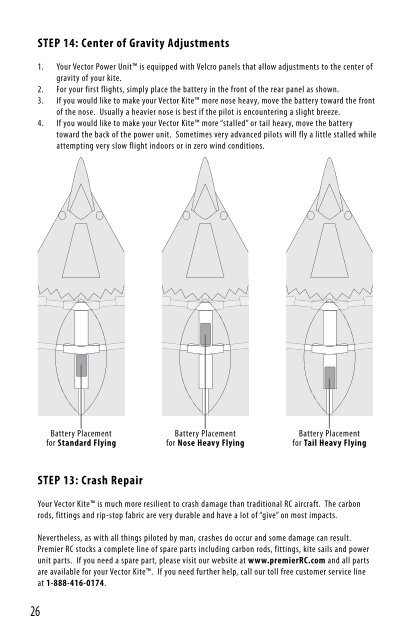Eagle - Premier RC
Eagle - Premier RC
Eagle - Premier RC
You also want an ePaper? Increase the reach of your titles
YUMPU automatically turns print PDFs into web optimized ePapers that Google loves.
STEP 14: Center of Gravity AdjustmentsWARNINGS AND SAFETY:1.2.3.4.Your Vector Power Unit is equipped with Velcro panels that allow adjustments to the center ofgravity of your kite.For your first flights, simply place the battery in the front of the rear panel as shown.If you would like to make your Vector Kite more nose heavy, move the battery toward the frontof the nose. Usually a heavier nose is best if the pilot is encountering a slight breeze.If you would like to make your Vector Kite more “stalled” or tail heavy, move the batterytoward the back of the power unit. Sometimes very advanced pilots will fly a little stalled whileattempting very slow flight indoors or in zero wind conditions.In all your flight endeavors, safety must come first! Please read your instructions and allwarnings carefully. Your Vector Kite is capable of creating serious injury to you and others if you donot read and follow the warnings and directions carefully.Your Vector Kite is not a toy. It should only be flown by adults or under strict adult supervision forages 15 and under.Keep the propeller away from all parts of your body. Keep the propeller away from all parts of yourbody even if it is not spinning! Do not let hair or loose clothing get close to the propeller especiallyduring launch because entanglement could cause injury.Do not fly your Vector Kite in windy conditions. In windy conditions it is very possible to loosecontrol of your Vector Kite and cause serious injury.Never fly your Vector Kite near or over people, highways, roads, houses, buildings, vehicles, traintracks, power lines, hard surfaces, water or trees.Never attempt to catch a Vector Kite while flying or landing because both the spinning propeller andmoving kite could cause injury.Use only a battery charger intended for the Lithium Polymer batteries that come with the VectorPower Unit. NEVER, NEVER, NEVER leave the charger unattended while charging the battery.ALWAYS place the battery and charger on a fireproof surface such as in a ceramic or metal pot and ona concrete surface. The potential for a damaged, defective or improperly charged battery to catch fireis very real.Never cut into a battery. Never use a battery that looks damaged from a crash. Never use a batterythat looks swollen. Do not use a battery that has damage to the wire insulation. Never intentionallyshort circuit a battery. READ ALL BATTERY WARNINGS STATED EARLIER IN THESE INSTRUCTIONS.Always hold a Vector Kite firmly when the battery is plugged into the Vector Power Unit to keepbody parts away from the propeller.Battery Placementfor Standard FlyingBattery Placementfor Nose Heavy FlyingBattery Placementfor Tail Heavy FlyingAlways turn the transmitter on first before plugging in the Vector Power Unit.Always unplug the Vector Power Unit first before turning off the transmitter.STEP 13: Crash RepairPlease use common sense. Fly Safe.Your Vector Kite is much more resilient to crash damage than traditional <strong>RC</strong> aircraft. The carbonrods, fittings and rip-stop fabric are very durable and have a lot of “give” on most impacts.Nevertheless, as with all things piloted by man, crashes do occur and some damage can result.<strong>Premier</strong> <strong>RC</strong> stocks a complete line of spare parts including carbon rods, fittings, kite sails and powerunit parts. If you need a spare part, please visit our website at www.premier<strong>RC</strong>.com and all partsare available for your Vector Kite. If you need further help, call our toll free customer service lineat 1-888-416-0174.26 27









